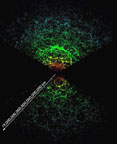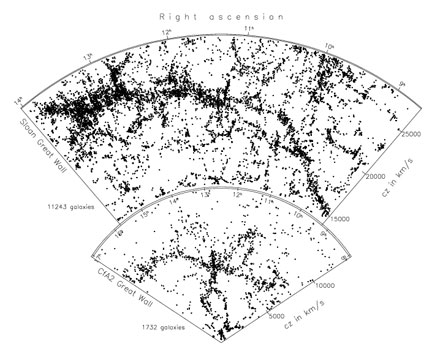
Sheets and Voids
About the Image

This map of the universe was done by The Sloan Digital Sky Survey (SDSS). It shows a 3D look at the universe that is 2 billion light years deep. Earth is at the very center. Each galaxy is shown as a single point, and the color represents its luminosity. The map shows only those 66,976 of the 205,443 galaxies that lie near the plane of Earth's equator. The large empty pie slices on the sides of the image are regions of the sky that are obscured by our Galaxy, or have not been mapped yet.
Surveys of distant objects reveal that the Universe has a bubbly structure - sheets and filaments of galaxies form a twisting web punctuated by large voids. These voids can be as big as several hundred Mpc in size and are thought to fill about 95% of space. The largest void observed so far (as of August 2007) is 280 Mpc or about 1 billion light years across. For more information about Voids try this link.
One of the candidates for "largest known structure in the Universe" is the "Sloan Great Wall", discovered in 2003 by J. Richard Gott III and Mario Juric and their colleagues, using SDSS data. The wall is nearly 1.5 billion light years in length and is located approximately one billion light years from Earth. The Sloan Great Wall is almost 3 times longer than the "Great Wall" of galaxies discovered in Margaret Geller and John Huchra's 1989 survey (which is also sometimes called the CfA2 Great Wall). At about 500 million light-years long, 300 million light-years wide and 15 million light-years thick, it was was previously the "record holder" for largest known structure.
Here is an illustration by Gott and Juric that shows both the Sloan Great Wall and the CfA2 Great Wall.
It should be noted that the Sloan Great Wall is not a "structure" in the technical sense as the components of it are not gravitationally bound together.
In 2006, astronomers using the Suburu telescope discovered a 200 million light year long filiment of galaxies. Each discovery like this helps us to better understand the structure of the Universe!
Distance Information
This image shows the Universe up to 19,000,000,000,000,000,000,000 km away from the Earth! Because this is such a large number, astronomers use Megaparsecs (Mpc) to measure these distances. 19,000,000,000,000,000,000,000 km is about 2 billion light years, and about 613 Mpc.
How do We Calculate Distances of This Magnitude?
Hubble's Law can be used to find distances of astronomical objects out to the limits of the observable Universe. For more info, please see the section on calculating the distances to the Nearest Superclusters.
Why Are These Distances Important To Astronomers?
Thestudy of the cosmic microwave background shows that the Universe was highly uniform shortly after the Big Bang, but the Universe today has clumps of matter at the scales of stars, galaxies, and clusters of galaxies. So how did these structures form? We don't know for sure yet, although there are good theories. To test the theories, we need to quantify how galaxies are distributed, particularly at the largest scales possible. That is, we need to measure the distribution of galaxies in sheets and voids. We cannot just photograph the sky to do this - we need to know the distances to thousands of galaxies to create a 3 dimensional map of the Universe, which is exactly what the Sloan Digital Sky Survey (SDSS) has done to create this image. Galaxies were identified in a 2 dimensional image, and then their distances were determined from their spectra to create a 2 billion light years deep 3D map! There is a press release about how they made this image here.
Travel Time
At the rate of Voyager's recessional speed of 17.3 km/sec, it would take more than 34,000,000,000,000 years to reach a distance of 613 Mpc. At the speed of light, it would still take about 2 billion years! This means that light from galaxies 613 Mpc away from Earth traveled for 2 billion years before it ever reached us. In effect, we are seeing these galaxies how they appeared 2 billion years ago. Far away things help us to peer further back in time.
Future Research
Are there structures that are on a still larger scale? It would take more extensive surveys to know. In only a few short years, we have gone from the 1998 Margaret Geller/John Huchra 150 Mpc survey to this Sloan Digital Sky Survey that goes out to over 600 Mpc. The Geller/Huchra survey mapped only about 1/10,000 of the total volume of the observable Universe. Margaret Geller pointed out that extending the results of this survery to the entire visible Universe is like using a map of Rhode Island to draw conclusions about the appearance of the entire surface of the Earth!



